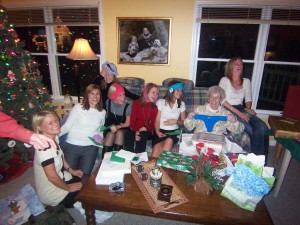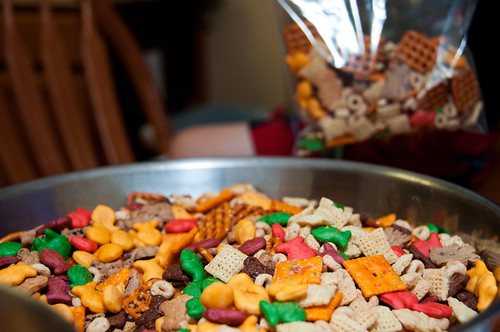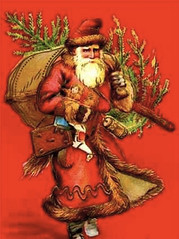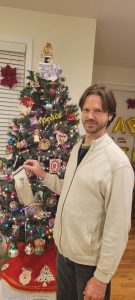by Mary E. Ulrich | Dec 20, 2024
For anyone who buys gifts for a person with autism or a disability, here is a fun twist on the classic poem which shares some of the reasons it is so difficult to find the perfect gift.
Cindy Waeltermann, is the founder of AutismLink and gives us permission to reprint her poem on behalf of her two children who are adults with autism.
Autism Night Before Christmas
by Cindy Waeltermann
Twas the Night Before Christmas
And all through the house
The creatures were stirring
Yes, even the mouse
We tried melatonin
And gave a hot bath
But the holiday jitters
They always distract
The children were finally
All nestled in bed
When nightmares of terror
Ran through my OWN head
Did I get the right gift
The right color
And style
Would there be a tantrum
Or even, maybe, a smile?
Our relatives come
But they don’t understand
The pleasure he gets
Just from flapping his hands.
“He needs discipline,” they say
“Just a well-needed smack,
You must learn to parent…”
And on goes the attack
We smile and nod
Because we know deep inside
The argument is moot
Let them all take a side
We know what it’s like
To live with the spectrum
The struggles and triumphs
Achievements, regressions…
But what they don’t know
And what they don’t see
Is the joy that we feel
Over simplicity
He said “hello”
He ate something green!
He told his first lie!
He did not cause a scene!
He peed on the potty
Who cares if he’s ten,
He stopped saying the same thing
Again and again!
Others don’t realize
Just how we can cope
How we bravely hang on
At the end of our rope
But what they don’t see
Is the joy we can’t hide
When our children with autism
Make the tiniest stride
We may look at others
Without the problems we face
With jealousy, hatred
Or even distaste,
But what they don’t know
Nor sometimes do we
Is that children with autism
Bring simplicity.
We don’t get excited
Over expensive things
We jump for joy
With the progress work brings
Children with autism
Try hard every day
That they make us proud
More than words can say.
They work even harder
Than you or I
To achieve something small
To reach a star in the sky
So to those who don’t get it
Or can’t get a clue
Take a walk in my shoes
And I’ll assure you
That even 10 minutes
Into the walk
You’ll look at me
With respect, even shock.
You will realize
What it is I go through
And the next time you judge
I can assure you
That you won’t say a thing
You’ll be quiet and learn,
Like the years that I did
When the tables were turned…….
Thanks to Trish Doerrler, a parent of a child with autism, for sharing this poem on her blog In so many words.
Hope you all have a fantastic Holiday, with lots of precious moments.
Aaron’s Favorite Gifts
This year we are getting Aaron a tape/CD player because Aaron thinks listening to music is an active sport. He loves putting the tapes (yes, tapes) in and out. We can find tapes in used book stores. They are usually pretty cheap, but that is great because then when they only last a couple days, they can be replaced. The hardest part will be to get the staff to understand the batteries are rechargable and should not be thrown out.
Aaron also likes to lick and flip baseball cards. He especially likes the ones with cheerleaders:)
I wish we had a longer list. He really isn’t impressed with new shirts and underwear.
Keep Climbing: Onward and Upward.
All my best,
Mary
Comments:
Which gifts work for your child? especially adults with autism or other disabilities? Are the gifts age-appropriate?
by Mary E. Ulrich | Dec 10, 2024

Grandma gets a Thong
Helen Otten, my mom, died April 3 at the age of almost 93. I’m posting this in her memory. I’m also reminded of the importance of family.
The twelfth day of Christmas is Jan. 6th–Little Christmas, The Feast of the Magi.
Actually, it’s all the Magi’s fault. They are the ones credited with giving the first gifts.
Based on the number of people in line at the return desks last week, I’d say many people had problems with their gifts. (Actually I could see Mary and Joseph thinking the gold was useful, they could buy a wagon or better donkey, but what were they supposed to do with Frankincense and Myrrh. Myrrh–really????)
I know it is supposed to be the “thought that counts,” but it really is much more. Gifts are a whole cultural phenomenon.
My mother is 89.
Recently she’s had hip replacement surgery and has trouble shopping for herself.
Two months before Christmas she told me she wanted slippers. Slippers it is. I don’t have to guess her gift. And this is great…EXCEPT
Every day for the next month she would call me on the phone (usually at 6 AM because that is when she wakes up and is thinking about slippers) and define what kind of slippers. They had to have rubber soles so she could wear them outside if she wanted. And this is great…EXCEPT
She couldn’t tell me her size. It seems some Large slippers are size 8-9, some Larges are size 9-10. And the manufacture, design, model, production all make a difference.
I went to three different stores and brought her “Pair number one” on Thanksgiving. She didn’t even try them on. Which actually made it easier to exchange them, which is great…EXCEPT
She really wanted black. But none of the stores made black slippers. So, I picked out some navy size 8’s and 9’s and 10’s, and some pink (everything she owns is pink) in a size 8-9, and 9-10. And I figured I’d give her a choice. Which was great…EXCEPT
She decided she wanted slippers that weren’t slip-ons. “Only the devil would make slippers with open backs” and she has had slippers that covered her whole foot, well–her whole life. And, she thinks she has ugly toes, so–none of those slippers with toe cut-outs. So, I boxed up and returned the slippers. And it was great…EXCEPT
The next three stores didn’t have black or whole foot slippers. But they did have navy.
You know where this is going, right?
Yep, I rebought her the same slippers (that she wouldn’t even try on) from the first round. She opened them on Christmas and said they were perfect.
So, it makes you wonder.
Was the gift really about slippers at all?
Grandma and the Thong
The picture above is from a previous Christmas. My sister Martha worked in a lingerie store and gave each of the girl cousins a pair of thongs. They thought they were nice. Certainly something practical they could use. EXCEPT
She also gave one to Grandma.
The gift became an urban legend in our family. It brought down the house.
Even though mom didn’t even recognize the thong as underwear—it was the shared experience with her grandkids that made it the perfect gift.
Which again makes me wonder about gifts.
Aaron’s Christmas Gift and Charity
This Christmas Aaron went to a Christmas Party sponsored by a local non-profit. These are kind folks. Many of the people with severe disabilities are the poorest people in the county and don’t even have family members who can give them gifts. So, this is not only a nice gesture, it is an opportunity for these poor souls to get a little something extra.
This year the non-profit got items donated by local businesses to give as gifts. Over 150 adults with disabilities came to the Christmas Party and Dance.
There are so few recreation opportunities, many of the people put on their best clothes and showed up early. Many more wanted to come, but there was little transportation and they depend on staff–who didn’t want to bother.
At the party, even though they arrived early, there were only chairs for 100 people. So Aaron and Jack, his roommate, had to stand and hold their coats.
Since Aaron has balance problems, and couldn’t understand why he couldn’t sit down (people were guarding their chairs) he started biting his hand and pinching others. Not good behavior at a party.
Their staff person made the sensible decision to leave (even more people were coming in the already over-crowded room). Aaron and Jack were each given a “gift bag” at the exit. Which was nice… EXCEPT
The gift bag had a pair of donated slippers. Yea! I would be laughing too, slippers… EXCEPT
The slippers were size 11.
Aaron wears a size 9.
Now, no one with balance issues is safe wearing a pair of slippers two sizes too big. And, unlike my mother, these slippers were charity—donated. So there was no gift card or receipt, most people had no dutiful daughter, family or staff who cared to make an exchange.
And, Aaron couldn’t understand why anyone would give him slippers he couldn’t use. So he just carried the slippers around the house—making me crazy that good, kind people could be so dumb. After all who is the “intellectually challenged” person here? Did they think they wouldn’t notice the slippers didn’t fit? Or all people wear size 11?
Is “Just getting something to open” the point? Even if they can’t use it?
What is Charity?
If you plan a charitable event and are giving gifts:
Don’t
Don’t just arbitrarily pass out slippers, or coats, or T-shirts with misspelled words.
Don’t give radios with no batteries—because they want to use the radio that minute and staff often won’t be bothered with batteries.
Don’t give them things you couldn’t sell or are broken.
Don’t make your interaction a one-time-event.
Do
Do have a party with chairs and refreshments for everyone.
Do get to know people as individuals
Do think about what YOU would want to get
Do think about normalization, age-appropriate entertainment and gifts.
Do think about transportation and staff and family members
Do consider that the shared experience, like Grandma getting the Thong, may be the best gift ever—no excepts.
Keep Climbing: Onward and Upward
All my best,
Mary
Comments:
Okay, best/worst gift stories? Am I just being an ungrateful jerk? What is the role of charity? Is it appropriate to give broken, torn things to Goodwill/charity? Only 258 shopping days until Christmas????
by Mary E. Ulrich | Dec 5, 2024

 photo credit: Holtsman
photo credit: Holtsman
Aaron’s Building Community Mix
Making New Friends
In my previous post: St. Nick| Community Building and Batman Socks, I talked about using the folk-story Stone Soup to begin a discussion about differences, scarcity, gifts and building a community.
To avert our St. Nick kindergarten disaster, the next day I brought in the ingredients for our Building Community Mix.
With other groups, I’ve made stone soup in a crock pot or adapted the activity in a couple different ways. One time, I had everyone bring in a piece of fruit and we made a community fruit salad. But the biggest success was always making Community Building Mix.
Each of the children participated and added their ingredient into our community pot–which was a large empty popcorn tin. Each student took a turn stirring and then rolling the tin to “cook” the ingredients. We shared our “Soup” and filled an extra baggie to give to a stranger, a child they didn’t know that attended our school.
The actual recipe is just a takeoff of ole Trail Mix.
It becomes a community building activity when each person in the group brings in one ingredient for a shared experience of working together.
I have used this activity with all age groups: pre-schoolers, special education students, Boy Scouts, university students, teachers, senior citizens…. A friend even used it with her Ladies’ Church Group as their culminating activity of friendship and sharing after a month long Bible Study.
It has also worked well for many holidays: Halloween, Thanksgiving, Birthdays, Summer Camp…
Great Holiday Gift Idea
It also works great as a homemade gift.
Aaron, my son who has the label of autism and intellectual disabilities, gave this as his annual teacher gift (one to each of his teachers, school secretaries, bus drivers, job coaches, therapists….). Since we wanted to include and thank as many people as possible, and have the gift be something that would enhance Aaron’s status as a person with skills and talents, this was perfect.
Twenty years later, his high school teacher still talks about “the mix.” It was a great way of thanking all the people in Aaron’s school or work community. And he got to be an active part of making it.
Partial Participation
In a related post I talked about how Tommy and Aaron “partially participated” in making Halloween treats.
Aaron
Aaron would “partially participate” by picking out the items at the grocery (his favorite were M&Ms), dumping the ingredients into the large popcorn tin. (Tape the lid on the tin.) He would roll the tin around to mix it up. Aaron would also help put the sticker: Aaron’s Holiday Mix on the top of the small holiday tin containers, snack bag, paper cups or plastic containers.
Tommy
Tommy would also help pick out the ingredients in the store (he favored Skittles). His job was to help stop Mom and Aaron from eating the M&Ms, as well as scooping the mix with a large ladle into the containers.
Since Aaron had fine motor issues and Tommy had great fine motor skills this worked out well. Each of the boys got to use their skills to make the mix.
Building Community Snack Mix
Box of Granola
Package of Mixed Dried Fruit Bits (found near the raisins in the grocery)
Raisins
Can of nuts
Pretzels, broken
M & M’s, chocolate chips, or Skittles
Other ingredients could be marshmallows, coconut, peanut butter chips, white chocolate, popcorn, cheese fish or crackers….
Invite your friends over and ask each to bring one ingredient.
Get out your biggest bowl, or put in a large popcorn tin (tape it shut). Combine all ingredients by shaking or stirring. Ladle into paper cups, plastic baggies, or in bowls. This is a great recipe for lunch snacks, parties, and teacher’s gifts. The mixed dried fruit bits are the magic ingredient.
Add Your Comments:
Have you used any similar experiences to build friendships, share gifts? Have you used “partial participation” to include others with various levels of skills? Is this an activity you can use?
Keep Climbing: Onward and Upward
All my best, Mary
by Mary E. Ulrich | Dec 1, 2024
St. Nick and the Batman Socks

 photo credit: frannie60
photo credit: frannie60
In Christmas 1981, Cincinnati Public Schools was involved in two class-action lawsuits. Our family was caught up in both of them.
The first concerned the right of Aaron, our then seven year old son, who had an IQ below fifty and the labels of autism and intellectual disability, to be able to attend public school instead of a segregated handicapped-only school, “with his own kind.”
The second lawsuit was about racial segregation and the development of “magnet schools” to bring together children of different races, socio-economic backgrounds, and learning styles. We voluntarily enrolled our youngest son, Tommy, age five, into Sands’ Montessori School in the inner city to promote desegregation.
While the lawyers thought the two cases were different, our family knew they were both about building an inclusive community, valuing diversity, and learning from each other.
One of our first lessons about diversity came on St. Nick’s Feastday, Dec. 6th.
In true German tradition, the evening before St. Nick’s Feastday, Tommy wrote letters to Santa for both himself and Aaron, tucked them inside their shoes and placed them outside their bedroom door.
The next morning, Tommy was thrilled to find St. Nick left a note asking him to help spread the spirit of Christmas, be nice to his mother (ah-hem), a couple of candy bars and a pair of Batman socks.
Tommy was always shy. But he was so excited to show off his Batman socks he strutted in front of the mirror, decided his pants covered too much of the socks, and tucked his pants legs inside his socks. Batman socks ruled!
I of course, thought this was darling, took pictures for his Kindergarten scrapbook and drove him to school thinking I was one terrific mom, er, St. Nick.
Tommy joined his class, and I was hanging out with the school secretaries when Tommy’s teacher called into the office asking me to come to the kindergarten room. Over the PA I could hear Tommy sobbing and the rest of the children clearly agitated.
It took a couple of minutes to sort out the details, but apparently Tommy had proudly shown his Batman socks at Show and Tell.
What he learned was no one else in the class had ever heard of St. Nick. And what was worse, St. Nick did not pick up anyone else’s note to Santa. So using sophisticated kindergarten logic, that meant no one–except Tommy–was going to get anything for Christmas.
Further, Tommy felt terrible he hadn’t told them about St. Nick. He reckoned this mess was all his fault. He was “not spreading Christmas cheer” as he had been told in St. Nick’s message, so Santa would be mad at him and not give him anything either.
Tommy’s tear-streaked face would have been bad enough, but he was curled under a desk in the corner with his bare feet hanging out. His Batman socks were inside-out in the garbage can.
Well, this was clearly a kindergarten disaster of monumental proportions. Tommy’s caring teacher and I exchanged those adult looks that said we were supposed to fix this. We settled the children.
I brought Tommy back into the circle, held him in my lap and reassured two other children who were sitting nearby.
Mr. Leedom read Marcia Brown’s story, Stone Soup.
Stone Soup
Stone SoupThe moral of the story is if we think in terms of “gifts” instead of “scarcity,” and if we see the unique beauty in our differences, customs and traditions, we will all have a richer life.
Community Building
After the teacher finished the story, I fumbled out a few words about our class being a community just like the people in the story.
Sometimes our family or religious traditions are not familiar to everyone. Just like each of the families in the story Stone Soup, our class was full of families that could contribute special stories and traditions to celebrate the holidays.
(Kindergartners are very generous in allowing grown-ups to tell stories to make themselves feel better.)
I told them St. Nick came to our house because we were of German descent. I asked if anyone else had other traditions around the holidays and one student told the story of Kwanzaa, another about Hanukkah. I reassured everyone they needed to talk with their families about their holiday traditions, but that if Santa brought them gifts last year, he would surely bring them gifts this year.
As I looked around the circle at these children I had come to love, it dawned on me this was not the all-white, German Catholic, middle-class community school in which I had grown up.
This was exactly the kind of learning experience we wished for our sons.
Intellectually, I knew this was why we chose this school. This sharing was the gift of diversity and inclusion.
But this was more. This experience was a transformational moment for me, Tommy and perhaps some of the students.
Community Building Mix
The next day I brought in the ingredients for our own version of Stone Soup— “Building Community Snack Mix” and gave each of the students a Batman sticker.
For more information click on the community building mix.
Batman Socks Rule!
Tommy did get his Batman socks out of the garbage can. He wore them all kindergarten and into first grade until they were faded and had a hole in the heel. The Batman socks are part of his childhood legacy.
New St. Nick Traditions
Each year, for the last forty years, we have placed the worn, torn Batman socks on our Christmas tree.

Tommy age 46 with his batman socks.
Now Tommy has two little girls of his own. The story of “St. Nick and the Batman Socks” is a cherished tradition to share with his daughters…and will continue to teach about diversity, community building, and inclusion.
Comments:
Do you have any St. Nick or holiday traditions that are unique to your family? Do you have any school memories about lessons in diversity, community building, or inclusion? Do you have other ideas on how to build community during the holidays?
Keep Climbing: Onward and Upward
All the best, Mary




